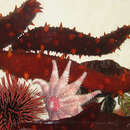pt-BR
nomes no trilho de navegação


The California sea cucumber (Apostichopus californicus),[2] also known as the giant California sea cucumber, is a sea cucumber that can be found from the Gulf of Alaska to Baja California. It is found from the low intertidal zone to a depth of 250 m (820 ft). They are most abundant in areas with moderate current with cobbles, boulders or bedrock. They are artisanally fished.
The California sea cucumber can grow to a length of 50 cm (1 ft 8 in) and a width of 5 cm (2 in). It has a soft, cylindrical body, with red-brown to yellowish leathery skin. It has an endoskeleton just below the skin. The mouth and anus are on opposite ends of the body. The mouth is surrounded by twenty retractable tentacles that are used to bring food in. Five rows of tube feet extend from the mouth to the anus. They use their tube feet located on the underside of their body to attach themselves to rocks.

The California sea cucumber is a scavenger that feeds on organic matter. They feed by sifting through sediments with their tentacles, or by positioning themselves in a current where they can use their tentacles to catch food flowing by.
A. californicus is a solitary nocturnal animal. When threatened, it can eviscerate, expelling its organs through its anus. It can also expel sticky filaments to ensnare or confuse predators.
These sea cucumbers have separate sexes, and eggs are fertilized externally. Spawning usually takes place in August, and each female can produce thousands of eggs. After fertilization, a larva is formed which metamorphoses into a sea cucumber after a few weeks.
The California sea cucumber (Apostichopus californicus), also known as the giant California sea cucumber, is a sea cucumber that can be found from the Gulf of Alaska to Baja California. It is found from the low intertidal zone to a depth of 250 m (820 ft). They are most abundant in areas with moderate current with cobbles, boulders or bedrock. They are artisanally fished.
Apostichopus californicus (anciennement Parastichopus californicus) est une espèce de concombres de mer de la famille des Stichopodidae.
C'est une grosse holothurie cylindrique, pouvant mesurer entre 25 et 50 cm de long pour 5 cm de diamètre. Elle est généralement rouge marquée de jaune vif, mais la couleur de fond peut aussi être orangée, rouge sombre ou brune. La peau est couverte de grosses papilles coniques généralement jaunes avec la pointe discrètement rouge. La bouche est en position antéro-ventrale, entourée de 20 tentacules peltés, et l'anus est en position terminale. La face ventrale (le « trivium ») est couverte de podia qui lui permettent de se mouvoir lentement[2].
On trouve cette holothurie dans le Pacifique nord-est, de l'Alaska à la basse-Californie. Elle vit entre la surface et 90 m de profondeur, sur des fonds mixtes et à l'abri du ressac[2].
Il a été prouvé en 2013 que cette holothurie est capable de se nourrir par son anus, en même temps qu'elle respire : ce stratagème leur permettrait de complémenter leur régime détritivore par un régime suspensivore[3].
Apostichopus californicus (anciennement Parastichopus californicus) est une espèce de concombres de mer de la famille des Stichopodidae.